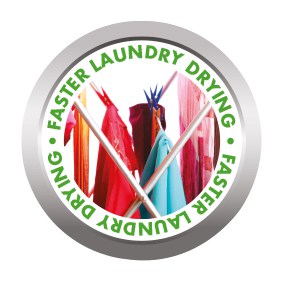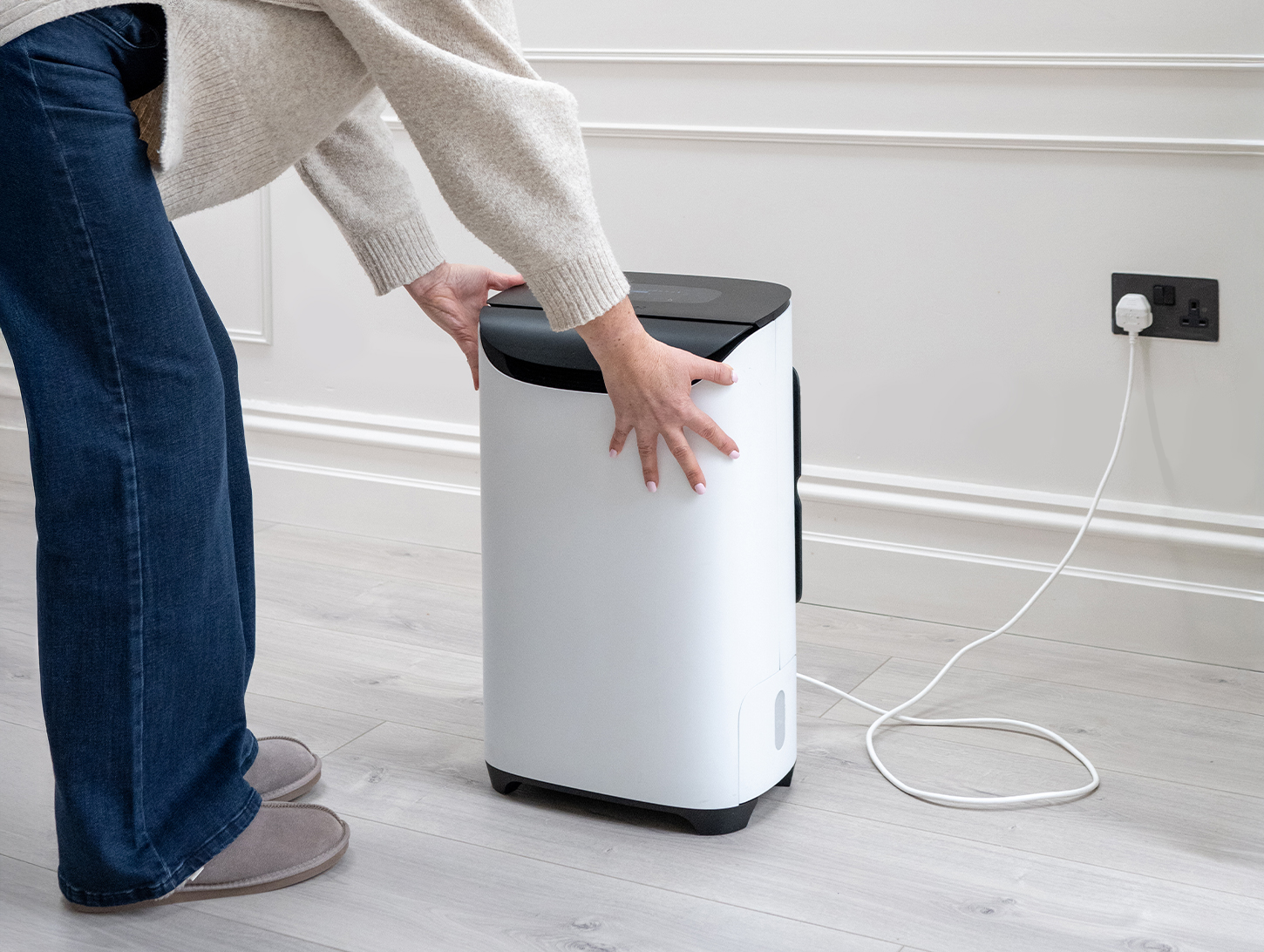A dehumidifier is a great investment for your home – especially if you are living somewhere with high humidity problems, condensation, damp or any of the other signs that there’s too much moisture in the air. Homeowners are often worried, though, by the question ‘how much does a dehumidifier cost to run?’.
The real cost of running a dehumidifier
It’s a fair question – and one we get asked a lot. There’s obviously a cost to buying the dehumidifier in the first place, and that will vary depending on the size and type of dehumidifier you choose. However, you can buy a good quality dehumidifier for under £150 and, when you consider how it could save money in the long run, it’s a great investment.
Once you’ve bought your dehumidifier, you’ll need to run it. This just requires access to an electricity point so you can plug it in. It’s hard to talk about exact running costs – this will depend on how long you run a dehumidifier – just a few hours a day? 12 hours? 24 hours? It’s likely that you’ll mostly run the unit during the colder months, because that’s when you need to reduce humidity caused by warm, moist air from showers, tumble dryers, drying washing indoors and cooking.
So the cost of running a dehumidifier 24/7 will obviously be higher than just running it when you are drying the washing, or for a couple of hours in the morning after everyone’s showered. We estimate that, on average, the running costs of a standard dehumidifier work out at less than £1 per day.
How dehumidifiers can save energy in your home
Buying or hiring a dehumidifier is not just about the initial investment, or daily cost to run. It’s also about where a dehumidifier can actually help you to save money:
- Cheaper heating bills – because the dehumidifier removes the moisture from the air in your home, it also removes the ‘chill’ factor, so you can run the heating less and at a lower temperature.
- No need to buy or run a tumble dryer – a dehumidifier is a really cost effective alternative to a tumble dryer. It’s cheaper and has multiple functions, so you are getting two units for the price of one.
- A healthier home environment – a dehumidifier doesn’t just deal with humidity, it also removes dust mites from carpets and soft furnishings, creating a drier, purer air environment in your home. This has a positive effect on allergies and health issues, meaning less time off work or school with ill health.
- Save money on expensive cleaning products – people who struggle with mould and condensation problems will find that a dehumidifier can sort things out. So no more time or money spent on deep cleaning, repainting or replacing soft furnishings.

A dehumidifier can cost less to run than a tumble dryer
Counting the cost of running a dehumidifier – behind the problem
We spend far more hours a day indoors than we do outside, especially in the winter months. And we want a clean, hygienic and comfortable environment to live in. So it should come as no surprise that homeowners are not prepared to put up with damp problems. We are working out that not only is this bad for our health but it is also bad for our wallet.
Mould spores that originate from the black mould you find in build in wardrobes, behind furniture and in shower rooms can trigger allergic reactions or respiratory problems which in turn can mean time off work and increased childcare costs. Dust mites love damper conditions and reproduce at a higher rate when the relative humidity is high.
Counting the cost of running a dehumidifier – behind the problem
We spend far more hours a day indoors than we do outside, especially in the winter months. And we want a clean, hygienic and comfortable environment to live in. So it should come as no surprise that homeowners are not prepared to put up with damp problems. We are working out that not only is this bad for our health but it is also bad for our wallet.
Mould spores that originate from the black mould you find in build in wardrobes, behind furniture and in shower rooms can trigger allergic reactions or respiratory problems which in turn can mean time off work and increased childcare costs. Dust mites love damper conditions and reproduce at a higher rate when the relative humidity is high.
Dust mite statistics are pretty grim:
• Your mattress can hold as many as 10 million dust mites
• 10% of a two year old pillow’s weight can be a mixture of dead and alive dust mites
• They love nothing more than feeding on our dead skin
• We produce enough to feed around 1.5 million of them per year.
• Dust mite droppings are released into the air and some people are allergic to the allergen that is within them (we breathe in their droppings!).

The costs of running a dehumidifier are small compared to the benefits.
Condensation and ventilation
Condensation on windows on a winter’s morning is irritating, especially when mopping it up becomes a daily chore. For those with wooden frames it will also mean a reduced lifespan for the windows and more regular replacement costs.
Poorly ventilated bathrooms are more likely to suffer from mould growth as the moisture from the shower and bath starts to build up excess humidity within the room. Bathroom ceilings and untiled walls will have to be washed down on a regular basis, sealant and grouting cleaned or replaced as they turn first brown and then black as the mould takes hold.
Drying laundry indoors during the winter – or all year long if you do not have access to an outside line – creates a build-up of moisture that will also create mould growth. This is most likely to form on colder north-facing outside walls and in poorly ventilated spaces – sofas pushed up against external walls, and built in wardrobes are most likely to show signs of mould first.
How much should a dehumidifier cost?
We’d always recommend getting the best dehumidifier as you can afford. Dehumidifier hire costs are affordable, but hiring is usually best for a one-off event like a natural flood, or excess water from a broken washing machine or dishwasher. A good quality dehumidifier, like the dedicated home dehumidifiers at Meaco, will cost an average of £200, and we think you will make that money back within just a few months of ownership.
Using a dehumidifier will help to keep your energy bills down. Helping to improve the air quality in your home, helping to dry your washing faster and more economically, helping to reduce condensation, and helping to manage problems with mould and more, it’s definitely an investment rather than a cost. Once you have started using the dehumidifier – and you’ll see results straight away – you’ll be able to measure the costs for yourself. And with extra features like timers so that the dehumidifier turns itself off automatically when it reaches the right relative humidity point, we’ve made our units as energy efficient and cost effective as possible, so that all you get is a drier, healthier home.
The new Platinum Range from Meaco offers exactly that with independent tests proving that the Meaco 12L and Meaco 20L Low Energy Dehumidifiers are cheaper to run than anything else on the market whilst still providing excellent performance. More details on the Platinum Range can be found here.
Products featured: Meaco 12L and Meaco 20L Low Energy Dehumidifiers







14 responses
Will one humidifier benefit a few rooms ( with doors open)..or will it only work in the room it’s placed?
June,
Thank you for your enquiry.
One dehumidifier can definitely benefit more than one room, as long as the doors are open and air can move freely between them. What happens is that the dehumidifier creates a slightly drier “pocket” of air around it, and because moisture naturally moves from more humid areas to drier ones, the surrounding rooms will gradually balance out too.
That said, air circulation is key—open internal doors to help the dry air travel, and positioning the unit centrally can improve coverage.
Each model on our website includes a guide showing what size space it’s designed for, so it’s worth checking that to make sure your unit’s capacity matches the area you want to treat.
Hope that helps!
Omar@Meaco
How much does it cost to run Meaco Arete One 25L dehumidifier and air purifier please. 296W and Unit rate 25.270 p/kWh @ 55 % RH
Syed,
Thank you for your question. Please note that we provide approximate electricity running costs on the technical overview tab of our product pages. For the AreteOne 25L, we recommend 7p per hour based on a rate of 24.50p per kWh. With your rates, the cost would be slightly higher, approximately 7.47p per hour, but we round it to 7p for simplicity. Keep in mind that wattage can vary depending on the environment and how often the dehumidifier is in use.
Kind regards,
Omar@Meaco.
How much does it cost to run Meaco Arete One 12L dehumidifier and air purifier please
Thank you for your comment,
The cost will vary on the fan speed which is factored by the conditions the unit is placed in. For example, at 20 °C and 60 % RH you expect to consume 151 watts, 4p / hour based on 27.35p / kWh.
For more examples please visit the product page and click on the extraction rate data.
https://www.meaco.com/products/meacodryarete1-12l
Hope this helps.
Omar@Meaco
How much does it cost to use a Meaco 25l dehumidifier please..
Thank you for your comment,
At an average of at 20 °C and 60 % RH you can expect 8p / hour based on 27.35p / kWh.
Please click the link below and see the details on the product page for more information:
https://www.meaco.com/products/meacodry-arete-one-25l-dehumidifier-and-air-purifier
Omar@Meaco
I have recently purchased a meaco dd8lj 8 litre
Junior desiccant dehumidifier
Can you give us an idea of running cost per hour
on each of the settings including Laundry
So far delighted with product
Graham,
Thank you for your purchase, the costs are;
11p / hour based on 34p / kWh on fan speed 1
22p / hour based on 34p / kWh on fan speed 1 and laundry mode
regards
Chris
Does it cost more per kwh to run the dehumidfier on laundry mode please?
No it doesn’t.
Is it better to leave dehumidifier in cellar or on the ground floor ?
Susan,
That depends where the problem is, always have the dehumidifier as close as possible to the problem and if that is in the cellar, and the cellar is closed off to the ground floor, then the dehumidifier will have to go into the cellar. If there is no door between the two, then you could try the machine at the top or bottom of the stairs as a compromise.
Chris